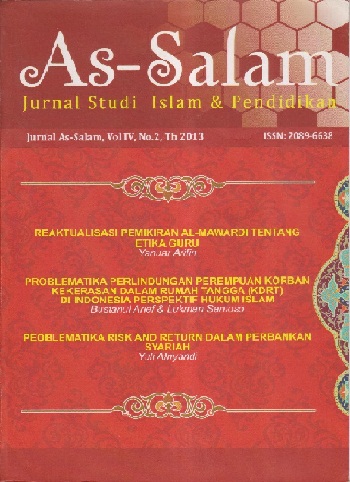PROBLEMATIKA RISK AND RETURN DALAM PERBANKAN SYARIAH
Abstract
The knowledge about risk in an investation is the important thing. Decision
of investaion for the investor is regarded the era that will come is unclear,
it is contains a risk for inverstor. In order that in Islamic perspective, basic
investation that needs to know in the institution of Islamic inance syariah
such as bank that also place to invest fund. In the system of Islamic economy,
ionvestation can decrease the poverty and increase the income with a
way to bene it the wealth productively. The investation activity which
agrees with Islamic syariah is the effort to produce the better life (falah),
giving the bene its (maslahah) and keeping away the way of forbidden
investation, that is riba, gharar, and maysir. But, productive investation can
be implemented with the cooperation and proffessional in doing the main
principle of syariat.
The control of risk in banking industry is the main part for investor to invest.
The management of this risk includes identi icating risk, measuring risk,
managing risk, limiting risk, and observing risk. Through this approach
the risk and the taking advantange can be measured. So the investor
will get the chance return or value of sharing resulit optimally and also
prospectively. The indeterminancy level of risk and return of result are the
challenge its self to the syariah banking. The validity of law “hish risk brings
about high return”forces syariah banking to apply the manage the risk that
is more superior from conventional banking. So that the syariah banking
must create a team that is able to manage and that is the include of the
menegement of risk its self.
Downloads
References
Anto, M.B Hendrie, Pengantar Ekonomika Mikro Islami. Yogyakarta:
EKONOSIA, 2003.
Ayub, Muhammad, Understanding Islamic Finance. Jakarta: PT. Gramedia,
Chapra, M. Umer, Al-Qur’an Menuju Sistem Moneter yang Adil. Yogyakarta:
PT. Dana Bhakti Prima, 1997.
Fatwa Dewan Syariah Nasional Nomor 03/DSN-MUI/IV/2000.
Ghofur, A. Anshori, Perbankan Syariah di Indonesia. Yogyakarta: Gadjah
Mada University Press, 2008.
Hana!i, M. Mamduh, Analisis Laporan Keuangan. Yogyakarta: UPP STIM
YKPN, 2007.
Iqbal, Zamir dan Abbas Mirakhor, An Introduction to Islamic Finance,
Theory and Practice. Singapore: Saik Wah Press, 2007.
Karim, Adiwarman, Bank Islam: Analisis Fiqih dan Keuangan. Jakarta: PT.
Raja Gra!indo Persada, 2006.
Mannan, M. Abdul, Teori dan Praktek Ekonomi Islam. Yogyakarta: PT. Dana
Bhakti Wakaf, 1995.
Muhamad, Manajemen Bank Syariah. Yogyakarta: UPP STIM YKPN, 2002.
Namora, 2006. Perbandingan Market Performance dan Karakteristik
Keuangan Perusahaan Sektor Aneka Industri dengan Sektor Properti –
Real Estat, Tesis, Program Studi Magister Manajemen Program Pasca
Sarjana Universitas Pelita Harapan Jakarta, 2006.
P. Jorion, The New Benchmark for Controlling Derivatives Risk: Value at
Risk, Jakarta: Irwin Professional Publishing, 1997.
Putu Anom Mahadwartha, “Kon!lik Keagenan Dalam Kebijakan Penetapan
Nilai Value-at-Risk Pada Industri Perbankan”, Manajemen USAHAWAN
Indonesia, Lembaga Manajemen Fakultas Ekonomi Universitas
Indonesia, Jakarta, No. 09/TH. XXXI (September 2002)
Rahman, Afzalur, Doktrin Ekonomi Islam. Jilid 4. Yogyakarta: PT.
DanaBhakti Wakaf, 1995.
Saeed, Abdullah, Menyoal Bank Syariah, Kritik atas Interpretasi Bunga
Bank Kaum Neo-Revivalis. Jakarta: Paramadina, 2004.
Warde, Ibrahim, Islamic Finance in the Global Economy. Yogyakarta:
Pustaka Pelajar, 2000.
Yudho Prabowo, Analisis Resiko dan Pengembalian Hasil pada Perbankan
Syariah: Aplikasi Metode VaR dan RAROC pada Bank Syariah Mandiri,
Journal La Riba Volume III, No. 1, Juli 2009.
















